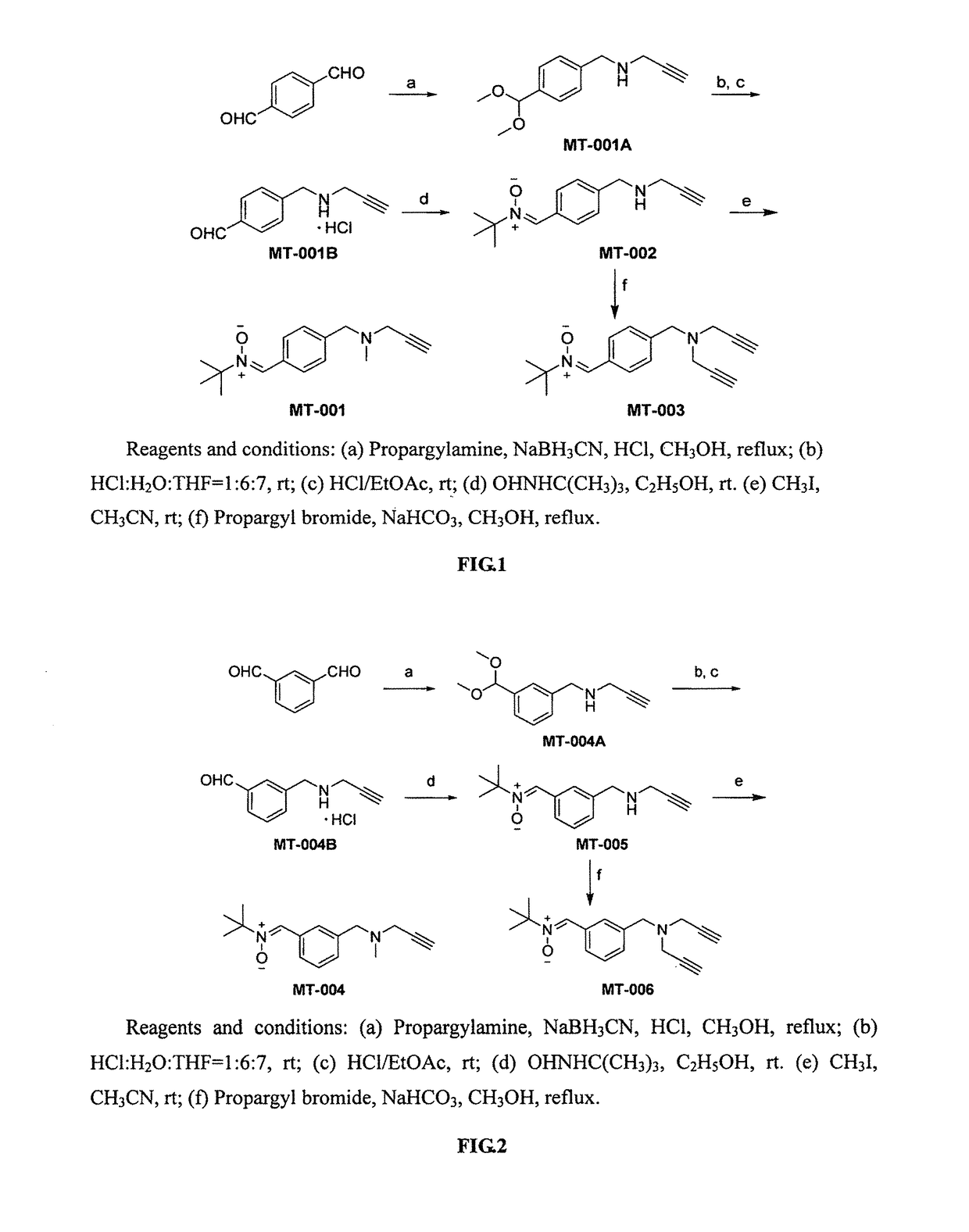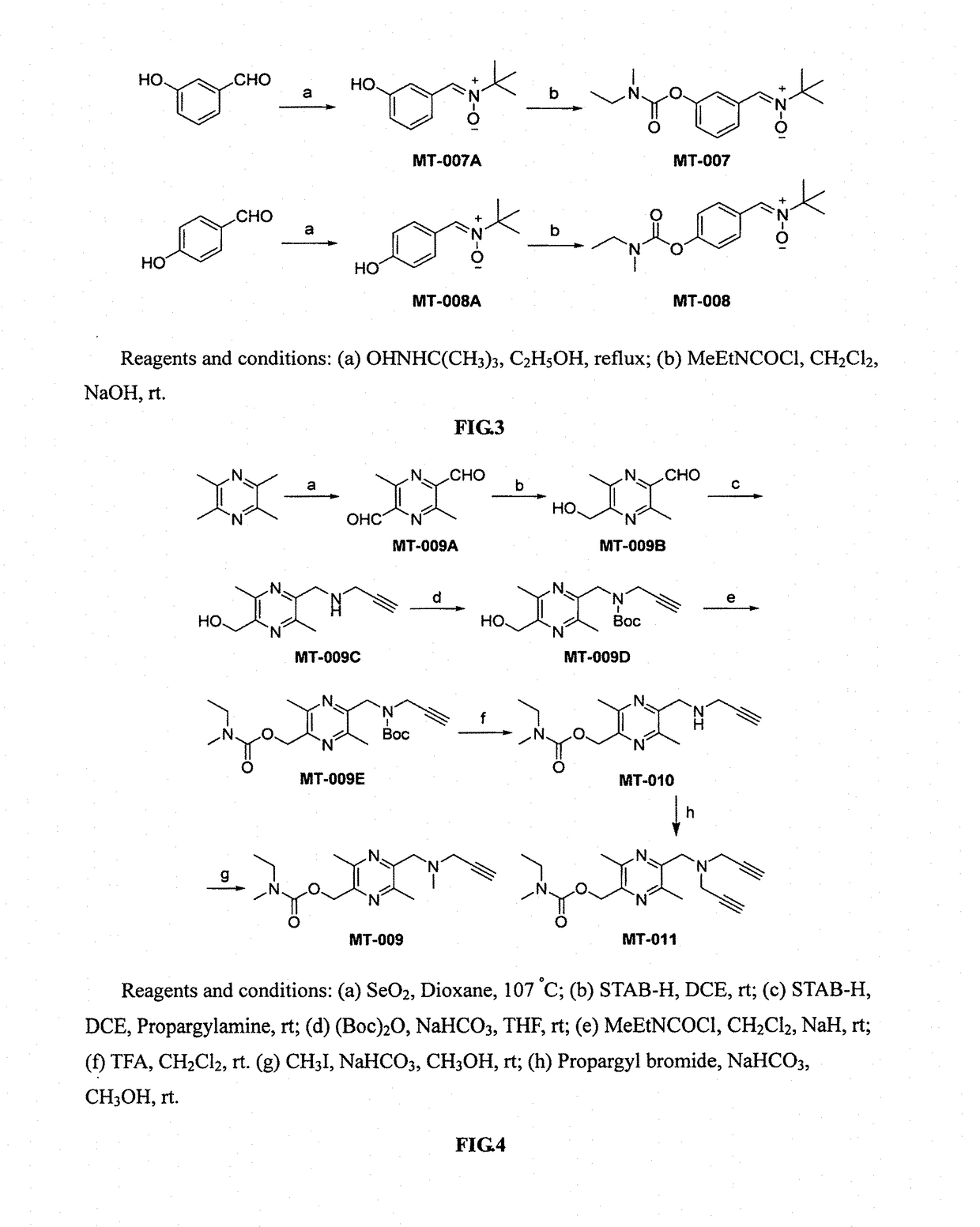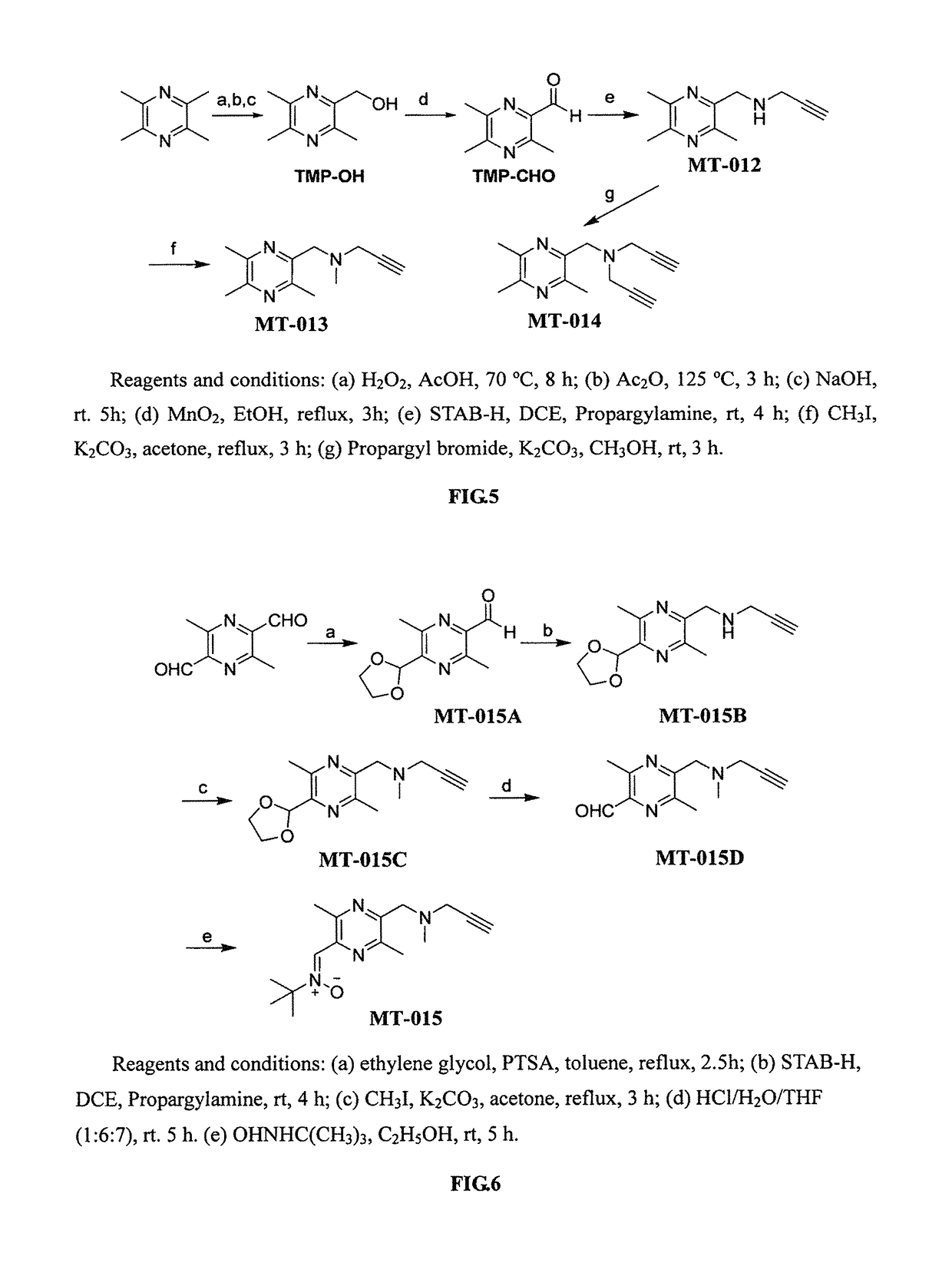Compounds with neural protective effect, and preparation and use thereof
a neural protective effect and compound technology, applied in the field of medical devices, can solve the problems of reducing the effect of oxidative stress, affecting the memory function of mice, and provoking the body's oxidative damage, and system may produce more severe oxidative stress effects
- Summary
- Abstract
- Description
- Claims
- Application Information
AI Technical Summary
Benefits of technology
Problems solved by technology
Method used
Image
Examples
example 1
of Compound MT-011A
[0097]p-Phthalaldehyde (1.34 g, 10 mmol) was dissolved in 25 mL of methanol, concentrated hydrochloric acid (1.5 mL) and propargylamine (0.66 g, 12 mmol) were added separately at room temperature, the solution was stirred for 10 min and NaBH3CN (1.26 g, 20 mmol) was added, and the reaction was heated to 68° C. and refluxed for 3 hours. The reaction was followed by TLC, solvent was evaporated after completion of the reaction, 20 mL of water was added, extracted 3 times with ethyl acetate (25 mL×3), the organic layers were combined and dried over anhydrous Na2SO4, then the solvent was evaporated under reduced pressure, the resulting material was separated with silica gel column (ethyl acetate:petroleum ether=1:3) to give the compound MT-001A as a colorless oil (1.7 g, 78%). ESI-MS: [M+H]+ m / z 220.4. 1H-NMR (CDCl3, 300 MHz) δ: 1.60 (s, 1H), 2.27 (t, J=2.4 Hz, 1H), 3.32 (s, 6H), 3.41 (d, J=2.4 Hz, 2H), 3.88 (s, 2H), 5.38 (s, 1H), 7.33 (m, 2H), 7.41 (m, 2H).
example 2
of Compound MT-001B
[0098]Compound MT-001A (0.5 g, 2.3 mmol) was dissolved in a solution of mixture of HCl:H2O:THF=1:6:7 (12 mL), the reaction was run at room temperature for 12 hours and monitored by TLC. After the reaction was complete, an aqueous solution of K2CO3 was added to adjust pH to neutral, extracted 3 times with ethyl acetate (15 mL×3), the organic layers were combined and dried over anhydrous Na2SO4, and passed through with anhydrous HCl gas, and a white solid was precipitated, allowed to stay for 1 hour, and filtered to give the compound MT-001B as a white solid (0.41 g, 86%). ESI-MS: [M+H]+ m / z 174.0. 1H-NMR (DMSO-d6, 300 MHz) δ: 3.30 (s, 1H), 3.76 (m, 1H), 3.89 (d, J=15 Hz, 2H), 4.22 (d, J=36 Hz, 2H), 4.43 (s, 1H), 7.37 (d, J=8.1 Hz, 1H), 7.51 (d, J=8.1 Hz, 1H), 7.77 (d, J=8.1 Hz, 1H), 7.97 (d, J=8.1 Hz, 1H), 10.05 (s, 1H).
example 3
of Compound MT-002
[0099]Compound MT-001B (0.25 g, 1.2 mmol) was taken, and an aqueous solution of NaHCO3 was added to adjust pH to neutral, then extracted with ethyl acetate, spin-dried, added to 25 mL of ethanol, then t-butyl hydroxylamine (0.2 g, 2.4 mmol) was added, and the reaction was run at room temperature for 8 and monitored by TLC. After the reaction was complete, the solvent was evaporated to dryness under reduced pressure, the resulting material was separated with silica gel column chromatography (ethyl acetate:petroleum ether=1:1) to give the compound MT-002 as a white solid (0.17 g, 57%). ESI-MS: [M+H]+ m / z 245.2. 1H-NMR (DMSO-d6, 300 MHz) δ: 1.50 (s, 9H), 1.99 (s, 1H), 3.09 (t, J=2.4 Hz, 1H), 3.28 (d, J=2.4 Hz, 2H), 3.76 (s, 2H), 7.36 (d, J=8.1 Hz, 2H), 7.81 (s, 1H), 8.30 (d, J=8.1 Hz, 2H).
PUM
| Property | Measurement | Unit |
|---|---|---|
| temperature | aaaaa | aaaaa |
| temperature | aaaaa | aaaaa |
| volume ratio | aaaaa | aaaaa |
Abstract
Description
Claims
Application Information
 Login to View More
Login to View More - R&D
- Intellectual Property
- Life Sciences
- Materials
- Tech Scout
- Unparalleled Data Quality
- Higher Quality Content
- 60% Fewer Hallucinations
Browse by: Latest US Patents, China's latest patents, Technical Efficacy Thesaurus, Application Domain, Technology Topic, Popular Technical Reports.
© 2025 PatSnap. All rights reserved.Legal|Privacy policy|Modern Slavery Act Transparency Statement|Sitemap|About US| Contact US: help@patsnap.com



